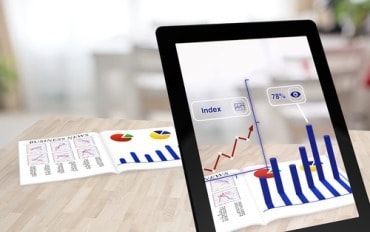
The numbers don’t lie. Businesses need data and the edge. Here’s how to get it right.
We’ve seen this movie before
Last weekend, we had a family movie night at our home. We had so much fun, except for the part where we had to figure out a movie that all of us wanted to watch together. After a few rounds of ideas, we used rock-paper-scissors to help us make the final selection on Netflix, from the abundance of immediately available movie options – including tailored recommendations. It occurred to me that this same scenario would have played out very differently when I was younger. Then, we visited a brick-and-mortar Blockbuster to rent a movie. Back then, Netflix was merely a fledgling company struggling for its survival.
Featured Resource: AI at the Manufacturing Edge [Download Now]In 2000, the now infamous event where Blockbuster declined Netflix’s offer to be acquired for $50 million foretold the events unfolding around us today. Data-first, data-anywhere businesses are winning – by extraordinary margins – leaving laggards in the dust. We’ve seen this movie before. Blockbuster went bankrupt in 2010, while Netflix skyrocketed, reporting 222 million subscribers and annual revenue of almost $26.7 billion dollars in 2021.

The data decade
Netflix knew then what many of us have since discovered. Their novel business model jumpstarted what Dell Technologies calls “the data decade.” Data businesses have taken the world by storm and are outperforming others by miles. The Nasdaq-100 shows us the story.
See also: An Overview of Edge Computing
The Nasdaq-100 is a large-cap growth index. Using market capitalization as the criteria, the index includes 100 of the largest non-financial companies listed on the Nasdaq Stock Market. Based on recent data, the companies with the largest market caps are all data-first, data-anywhere businesses: Apple, Microsoft, Google, and Amazon. Their collective market cap is around $10T, which represents 67% of the value of the entire Nasdaq-100. That means the market cap of the other 95 companies listed on the Nasdaq-100 only represents 1/3 of the index’s total value. The value of these top companies – digital and data companies — significantly surpasses other leading global businesses.
Data businesses are winning
The truth is, whether we fully recognize it or not, every business is a data business. Those that embrace the power of data will increasingly outpace competitors and elevate business outcomes.
Tesla is an incredible example, winning the race by using data, artificial intelligence (AI), and the Internet of Things (IoT). Tesla gathers data from all of its vehicles and drivers using internal and external sensors. This data is used to continually hone Tesla’s self-driving assist system, educate its vehicles using AI / ML and provide value to Tesla’s customers. And the market value of the data itself is enormous. McKinsey and Co estimate that vehicle-gathered data will be worth $750 billion a year by 2030.
Tesla’s market cap, as the number 6 company on the Nasdaq-100, is $1.204 billion. That is 4.6 times greater than the next closest automotive competitor, Toyota, valued at $262 billion. The numbers don’t lie. Data businesses are edging out the competition.

What does the edge have to do with it?
Across industries, data is a competitive differentiator. But not all data has the same value.
Data at the edge refers to data gathered “at a location” from IoT devices or sensors, for example, in industrial plants, vehicles, or smart buildings. The volume of IoT data collection devices is skyrocketing, creating corresponding exponential growth in data and edge computing. Concurrently, these devices are elevating the value of this “new” data to generate richer, deeper, and more timely insights that help transform business outcomes and improve lives.
For example, retail stores can use sensors and cameras to calculate shoppers’ items and automatically charge their credit cards without a cashier. (Read more about this here). Smart cities can use edge computing to improve energy efficiency via lighting controls that operate lights for maximum efficiency and public safety. Manufacturing can use sensors to safely control operations or be alerted to impending equipment failures before they occur. (Read more about this here). Or in healthcare, wearable devices can provide patient data to medical professionals to proactively monitor and communicate patient conditions.
Giving businesses an edge
Edge adoption is skyrocketing, forecast to reach $168 billion with a CAGR of 24.51% by 2030. Businesses that use edge computing to process data at the edge are the frontrunners of tomorrow. The edge provides the ability to analyze new data and translate it into valuable, actionable insights – in near real-time. But not all data at the edge needs to be processed and analyzed immediately. Alternatively, the edge can also be used to capture new data, size it down and store it in the cloud for use at a later time. In addition to providing internal business value and competitive advantage, this data and its insights also provide external market value to others and can be monetized for the greater good.
Featured Resource: AI at the Manufacturing Edge [Download Now]The edge is giving an edge to businesses around the world. It is early in its adoption, creating lots of energy, excitement, and opportunity ahead. As edge computing unfolds, it is delivering powerful possibilities to industries around the world. Blockbuster taught us well that this is not a movie to stand by and watch; it is a movement to be a part of — starting today.
To learn more about the edge in a brief video, click here.







